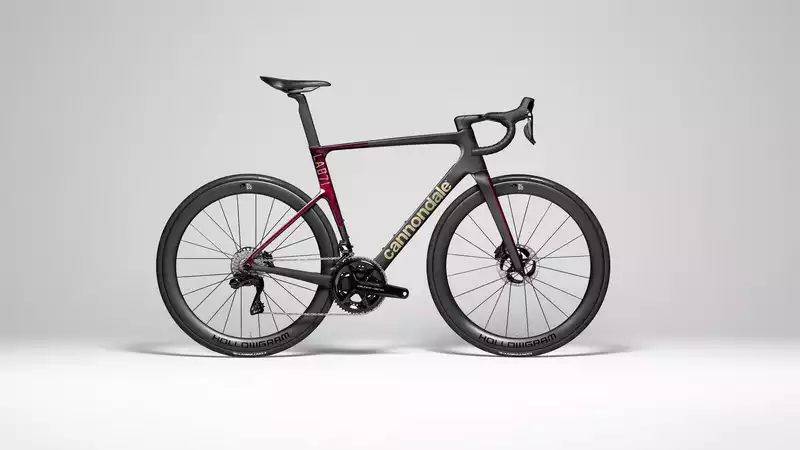A few weeks ago, Cannondale finally officially unveiled the new Super Six Evo 4. We were lucky enough to get a first look at the bike and put some miles on it in the hills of Girona. Nevertheless, we will discuss the official details here.
The new SuperSix is designed to be, as Cannondale puts it, "fast everywhere." It is an all-around race bike like Specialized's Tarmac SL7 or the new Canyon Ultimate, with the weight of a climbing bike, but with enough aero performance for flat terrain. In effect, it wants to be one of the best road bikes in its category.
While the design aims to be lightweight and aero, like all new bikes, Cannondale also took pains to stay true to the character of the current Super Six Evo 3 model. Stack, reach, head angle, wheelbase, and all the important points are the same. The only difference is that the seat stays are slightly lower. Sizing varies slightly depending on which frameset the SuperSix is based on, but in general it accommodates sizes 44 through 61. The big news from a sizing perspective is that the size 60 and 62 options will be merged into the new size 61.
Frames, both stand-alone and complete, are available in three types: carbon, Hi-Mod, and the new LAB71. The size 56 framesets weigh 930g, 810g, and 770g respectively; the LAB71 models reach the UCI weight limit of 6.8kg right out of the box.
Regardless of the carbon layup, all frames have the same shape and therefore the same aerodynamic performance (except for the build kit). The new SuperSix saves 12 watts over the old model at 45 km/h, making up more than half of the shortfall the old model had over the SystemSix. In addition, each model has clear 34 mm tires front and rear.
As speculated before the announcement, the new SuperSix is indeed equipped with a threaded bottom bracket, and it is made by BSA, not a T45 unit. First, there is an integrated battery holster at the base of the downtube, just in front of the BB. This not only lowers the center of gravity, but also allows for a thinner seat post, as seen on the recent Pinarello F, further increasing the aerodynamic efficiency of the frameset.
The front fork steerer is triangular, with room for hoses and cables (also compatible with cable-driven group sets). The apex of the triangle is rounded and can be combined with a standard stem by using a spacer. With longevity in mind, the fork's steerer, named "Delta Steerer," is covered with a wear-resistant layer to avoid the problem of hoses eroding the steerer.
The LAB71 frameset and lower complete bikes feature Cannondale's concealed stem, which places the cable routing underneath rather than inside; the LAB71 complete and the higher-end Hi-Mod 1 models have racing car steering wheels The LAB71 Complete and the higher-end Hi-Mod 1 feature a fully integrated one-piece system designed in collaboration with MOMO, the company most famous for its racing car steering wheels.
The final physical detail of the frame is the blind dropout of the fork. This means that the through-axle threads do not protrude on the opposite side of the dropout. While this does not necessarily help in terms of aerodynamics, it is intended to provide a clean aesthetic when viewed from the drive side. Aesthetics are clearly not an afterthought, with as many as 13 color options available. Some models use a "forged carbon" surface layer that mirrors the top surface of the MOMO bars, creating a more interesting textural dynamic.
There are also a pair of aero bottles around. These are standard bottles with the sides cut off. They are only compatible with the attached cage, but if you are a traditional hydrationist and insist on drinking exclusively from the cylinders, you can put a standard bottle in the cage.
Also beyond the frameset are two sets of Hollowgram wheels: the R-SL 50 and R-S 50, weighing 1,520 g and 1,620 g respectively, with 50 mm front and rear depth, 21 mm inside and 32 mm outside, with DT-Swiss hubs and hooks Includes.
For those not satisfied with Hi-Mod (short for High Modulus, a stiffer carbon), Cannondale recently introduced the LAB71. The new SuperSix Evo will be its first bike, although details of the official launch are not available; the LAB71 will span all genres, including road, gravel, MTB, and e-MTB, and will be the new top tier. Lighter frames, more premium builds. Think S-Works for Specialized, AMG for Mercedes.
The LAB71 version of the new Super Six is constructed of a new "Series 0" carbon, a different layup than the Hi-Mod and carbon models, and uses a special "nanoresin". Trendy term or not, it is a lighter frame. Interestingly, looking at the UCI approved frame list, we initially assumed the LAB71 model to be a lower model, indicated by the suffix "SL". It appears that the EF team bike we witnessed was a Hi-Mod frameset painted in the LAB71 livery.
.

Comments